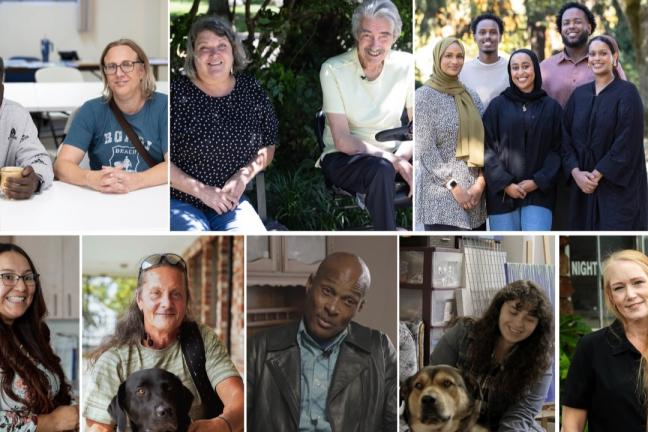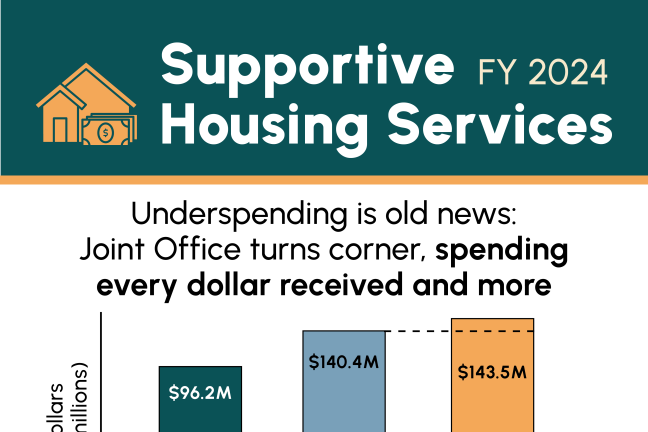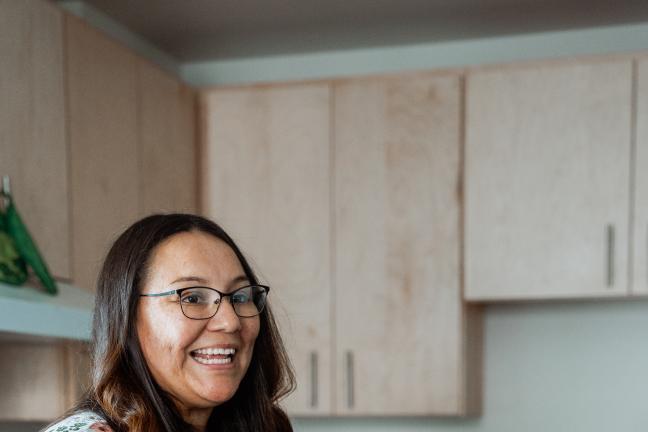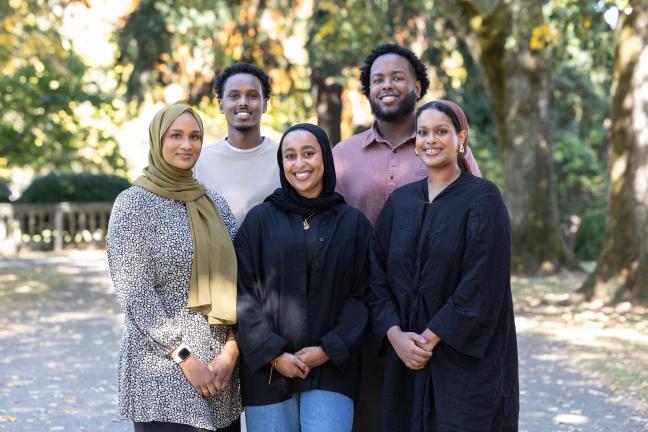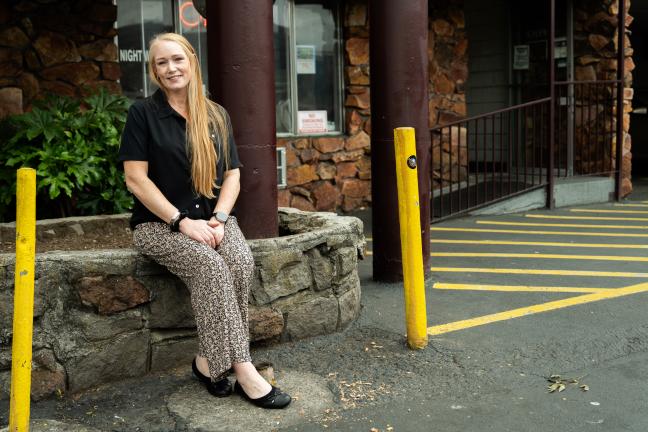The voter-approved Supportive Housing Services (SHS) Measure helped thousands of people leave homelessness for housing last year, while also adding behavioral health, substance use and daytime services, and supporting shelter and street outreach programs.
And in contrast with previous years’ spending, a new annual report from the Joint Office of Homeless Services also makes clear that the Joint Office of Homeless Services spent every new dollar it received from the measure last year and more, and has allocated every other remaining dollar carried over from the previous two years.
Spending challenges in the prior years were driven by two factors — revenues that vastly exceeded Metro’s forecasts, as well as staffing and contracting challenges that have since been solved.
Changes being contemplated by Metro to the SHS Measure will result in more uncertainty in future spending, which may result in fewer available services.
The SHS Measure — approved by voters in 2020, with limited funds first arriving from Metro in 2021-22 — has vastly expanded the resources available to local counties to expand supportive housing, shelter, street outreach and other programs focused on helping people leave homelessness for permanent housing. Three years into the measure, Multnomah County has built up the necessary infrastructure to put the measure’s goals into action.
“I’m proud the Joint Office continues to make such strong gains in performance and spending and we’ve been successful in increasing the urgency and accountability of this critical work,” said Multnomah County Chair Jessica Vega Pederson. “While there is still much work to do, this means better support for people who are connecting to our services and a stronger, healthier Multnomah County for the future.”
“This measure is working and is making a difference in our community, right now,” said Joint Office director Dan Field. “We’ve turned the corner on past underspending, and supported our providers in sheltering and housing thousands as a direct result of this measure.”
Between July 1, 2023, and June 30, 2024, Multnomah County and the Joint Office of Homeless Services used SHS funding to:
- Support 2,322 people in leaving homelessness for housing, a 76% increase over the previous year, thanks to the work of dozens of service providers. This is a significant portion of the overall total of 5,477 people who left homelessness for housing last year overall in Joint Office programs.
- Serve 1,160 people in emergency and behavioral health shelter beds. While significant, this is just a fraction of the 9,101 people served in shelter overall last year in Multnomah County.
- Serve 2,675 people with outreach, legal services, and employment assistance.
- Create 105 additional recovery and stabilization beds.
- Expand capacity at day services providers, allowing for more than 90,000 additional visits annually.
- Expand capacity at culturally specific providers, distributing $17.7 million to culturally specific service providers — a 91% increase over the allocated amount from the previous fiscal year.
- Lead with equity with a focus on reducing racial disparities seen among people experiencing homelessness. Black, Indigenous and other People of Color (BIPOC) made up 66% of people housed in SHS-funded permanent supportive housing and 64% of people housed in SHS-funded rapid rehousing.
- Distribute $10 million in workforce stabilization grants to 61 homeless services providers, with a focus on helping reverse ongoing challenges in the homeless services workforce.
Click to read the full report.
Focus on behavioral health and substance use investments
This year, Multnomah County used about $15 million in SHS dollars to expand addiction treatment services. The Joint Office distributed SHS dollars to the County’s Behavioral Health Division to expand programs focused on people living with substance use disorders. In total, the investments are leading to 105 additional recovery-oriented, stabilization and transitional housing beds (83 recovery-oriented beds, 10 transitional housing beds and 12 stabilization housing beds).
The Behavioral Health Division Awarded $5.05 million in unanticipated SHS funds to seven providers to bring on 83 additional recovery-oriented beds. Recovery housing is a cost-effective and evidence-based program that provides individuals in remission from substance use disorders a community living environment that is often coupled with ongoing treatment and recovery services. SHS investments allowed for the following expansion in recovery beds:
- Juntos NW, 11 beds, focused on providing culturally-specific care to individuals who are Latino/a/x
- Miracles Club, 9 beds, focused on providing culturally-specific care to individuals who are Black and African American
- Quest Center, 9 beds, focused on providing culturally-specific care to participants of The Resilience Initiative, an outpatient substance use program focused on individuals who are Black and African-American
- Project Patchwork, 12 beds, for parents/families in early recovery (priority for single fathers and their children)
- West Coast Sober Housing, 13 beds, focused on providing culturally specific care to individuals who identify as LGBTQIA2S+
- Volunteers of America, 14 beds, 50% are intended for men of color
- Lasko Refuge, 13 beds, focused on providing culturally-specific care to individuals who identify as LGBTQIA2S+
In addition, braiding together multiple funding streams, the Behavioral Health Division directed $850,000 in SHS funds, and a $1.2 million one-time funding grant from CareOregon, to provider Bridges to Change to open and staff two housing programs. One program provides short-term (14 days) stabilization housing for 12 people, and a second program provides four to six months of transitional housing for 10 people.
Joint Office exceeds SHS spending goals
The Joint Office of Homeless Services exceeded its spending goals agreed upon with Metro, the government agency that collects the tax and oversees the measure’s implementation. The department spent every dollar collected by Metro last year, meaning that spending was apace with revenue from the measure — even as Metro’s collections greatly exceeded its forecasts.
Originally, Metro had forecast that Multnomah County would receive $96.2 million in SHS dollars for FY 2024. In actuality, significant unanticipated revenue meant that Multnomah County received $140.4 million from Metro. Despite this huge difference between forecast and actual revenue, Multnomah County rose to the challenge by programming, allocating and then spending $143.5 million — dollars that have a direct impact on the lives of people experiencing homelessness.
Most people leaving homelessness for housing stay there, data shows
Permanent supportive housing, an intervention proven to help people leave chronic homelessness, is one of the central investments of the SHS Measure.
Because it pairs deeply affordable housing with tailored, wraparound services, permanent supportive housing helps people find stability in housing and remain there long-term.
This year, the Joint Office is reporting that 89% of households in SHS-funded permanent supportive housing remained in housing one year later. This was well above the Joint Office’s 85% goal for one-year retention rates. While this rate is below the reported retention rate from last year’s SHS annual report, a drop was expected as the program continues to grow and more people enter this type of housing.
And for rapid rehousing — which provides a shorter term housing subsidy (usually up to 12 months) and supportive services — 85% of people reached by the Joint Office remained in housing one year after their subsidy ended and they were on their own.
These trends show that housing, in combination with supportive services, can permanently end someone’s homelessness.
Stories show impact
The new report includes several feature stories focused on people who were directly supported by the measure and highlights specific programs made possible with SHS funding. All the stories can be found at this landing page.
“I have a job. My daughter’s happy. Life is good today.” Monique went from years of instability and addiction to living in permanent supportive housing with her daughter.
“It’s like my life is brand new.” Eric is housed with support from a Joint Office of Homeless Services pilot program focused on serving people who cycle through the criminal justice, emergency medical and homeless services systems.
“Everything is easier when you have housing.” Brian went from sleeping in a tent to a place of his own, thanks to the SHS-funded Housing Multnomah Now program.
“Sitting down, having a coffee, and being able to share your experience is really vital to your own mental health.” Day services providers like Ecumenical Ministries of Oregon are able to expand their services thanks to the SHS measure.
